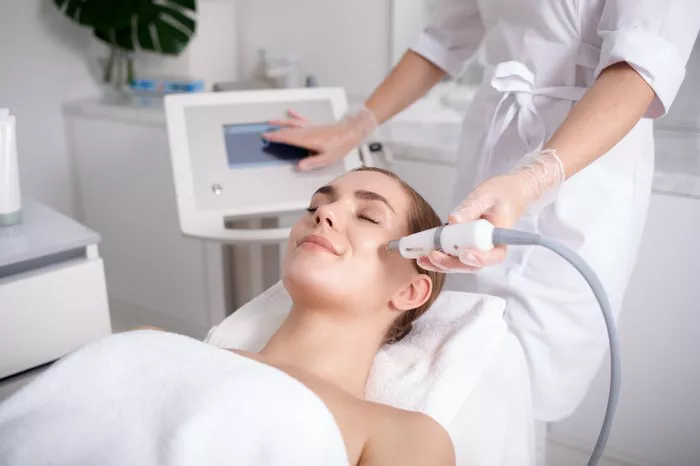Microdermabrasion treatments are a popular non-surgical cosmetic procedure that involves the use of a handheld device to exfoliate the outermost layer of the skin. The procedure is designed to improve the texture and tone of the skin, reduce the appearance of fine lines and wrinkles, and promote an overall brighter, more youthful complexion. In this article, we will explore how many microdermabrasion treatments are needed to see results.
How does microdermabrasion work?
Microdermabrasion is a minimally invasive procedure that uses a handheld device to exfoliate the skin. The device typically uses a combination of suction and abrasive materials, such as diamond particles or crystals, to remove the outermost layer of dead skin cells from the surface of the skin.
Microdermabrasion can be performed on the face, neck, chest, hands, and other areas of the body. The procedure is designed to improve the texture and tone of the skin, reduce the appearance of fine lines and wrinkles, and promote an overall brighter, more youthful complexion.
How many microdermabrasion treatments are needed to see results?
The number of microdermabrasion treatments needed to see results can vary depending on several factors, including the individual’s skin type, the severity of their skin concerns, and the type of device used.
Most skincare professionals recommend a series of six to ten microdermabrasion treatments, spaced two to four weeks apart, to achieve optimal results. However, the exact number of treatments needed can vary depending on the individual’s specific needs and goals.
Individuals with more severe skin concerns, such as deep wrinkles or acne scars, may require more treatments than those with milder concerns. It is important to note that microdermabrasion is not a one-time solution and requires ongoing maintenance to maintain optimal results.
What are the benefits of microdermabrasion treatments?
Microdermabrasion treatments offer a range of benefits for the skin, including:
Exfoliation: Microdermabrasion helps to remove dead skin cells and promote cell turnover, resulting in a brighter, more youthful complexion.
Reduced appearance of fine lines and wrinkles: Microdermabrasion stimulates collagen production, which can help to reduce the appearance of fine lines and wrinkles.
Improved skin texture and tone: Microdermabrasion can improve the overall texture and tone of the skin, resulting in a smoother, more even complexion.
Reduced appearance of acne scars and hyperpigmentation: Microdermabrasion can help to reduce the appearance of acne scars and hyperpigmentation, resulting in a more even skin tone.
Increased absorption of skincare products: Microdermabrasion can help to increase the absorption of skincare products, allowing them to penetrate deeper into the skin and provide more effective results.
What are the risks of microdermabrasion treatments?
While microdermabrasion is generally considered safe, there are some risks associated with the procedure. These include:
Skin irritation: Microdermabrasion can cause skin irritation, particularly if the device is used too aggressively or if the individual has sensitive skin.
Infection: Microdermabrasion can increase the risk of infection if the device is not properly cleaned and sanitized between uses.
Damage to the skin: Microdermabrasion can cause damage to the skin if the device is used too aggressively or if the individual has certain skin conditions, such as rosacea or eczema.
Sun sensitivity: Microdermabrasion can make the skin more sensitive to the sun, increasing the risk of sunburn and other types of skin damage.
How to prepare for microdermabrasion treatments?
Before undergoing microdermabrasion treatments, it is important to prepare the skin to ensure optimal results and minimize the risk of complications. Here are some tips to prepare for microdermabrasion treatments:
Avoid sun exposure: It is important to avoid sun exposure for at least two weeks before the procedure, as this can increase the risk of sunburn and other types of skin damage.
Avoid certain skincare products: Certain skincare products, such as retinoids and alpha-hydroxy acids, can increase the risk of skin irritation and should be avoided for at least one week before the procedure.
Avoid waxing and depilatory creams: It is important to avoid waxing and depilatory creams for at least one week before the procedure, as these can increase the risk of skin irritation and damage.
Stay hydrated: Drinking plenty of water can help to keep the skin hydrated and improve the overall health of the skin.
Speak with a skincare professional: It is important to speak with a skincare professional before undergoing microdermabrasion treatments to ensure that the procedure is right for you and to discuss any potential risks or complications.
Conclusion
Microdermabrasion treatments are a popular way to improve the appearance of the skin without the need for invasive procedures. While most individuals will require a series of six to ten treatments to achieve optimal results, the exact number of treatments needed can vary depending on the individual’s specific needs and goals. If you are considering microdermabrasion, it is important to speak with a skincare professional to determine whether the procedure is right for you, and to ensure that you are using the device safely and effectively. With proper care and maintenance, microdermabrasion can help to improve the texture and tone of the skin and promote a more youthful, radiant complexion.


